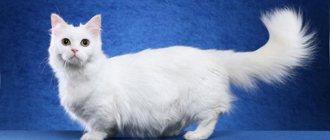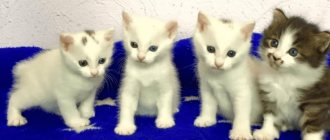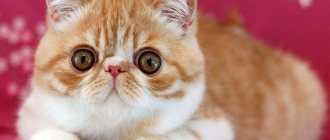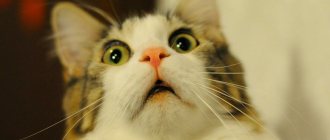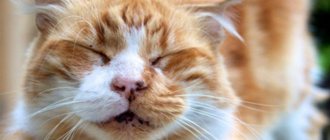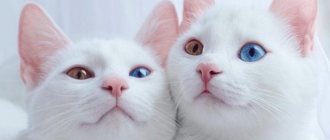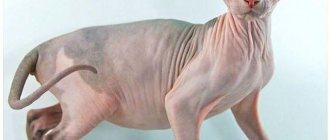The phenomenon of different eyes
Variegated eyes as a phenomenon has a scientific name - heterochromia (from the Greek heteros - “different”, chromos - “color”).
Heterochromia, different pigmentation of the iris, results from varying concentrations of the pigment melanin and occurs in both animals and humans. Gender does not matter in this case, although according to statistics, females with this phenomenon are more common. Heterochromia is often inherited and does not affect visual acuity in any way. The most common combination of different eyes is blue and brown; in felinology it is called copper. This unique phenomenon is called heterochromia and occurs not only in cats, but also in other animals and even in humans. Scientists have not yet fully figured out the reasons for its appearance. Today, there are several factors that influence different eye shades in animals:
- 1. Lack or excess of melanin pigment, which is responsible for the color of the iris, color of the animal’s fur and skin. The color tone of the iris depends on the concentration of this substance and the uniformity of its distribution.
- 2. White-haired gene W. Some cats carry the white-hair gene in their DNA from generation to generation, and with it a genetic predisposition to different-colored eyes. It is worth noting that these genetic mutations can appear in absolutely any individual, regardless of breed. This gene also carries the risk of death of the offspring in the womb.
- 3. Presence of diseases. Very often, heterochromia occurs in animals prone to cancer, leukemia, etc.)
It is worth noting that multi-colored eyes are found not only in completely or partially white cats, but also in black, tortoiseshell, or animals of other colors. Variations in eye colors are also different. The most common combination is yellow and blue, but there can also be blue with gold, green, brown, orange, etc. The following varieties of this anomaly are distinguished:
- Partial. With it, not the entire iris is painted in different colors, but only certain parts of it.
- Full. When each eye has its own color.
- Congenital. Caused by a hereditary mutation.
- Acquired. Occurs due to the presence of any disease and long-term use of medications.
We recommend
We invite you to read: How to stop a puppy from biting and grabbing - 4 simple steps
Why do cats lose their fangs?
Tortoiseshell color. Characteristics
True tortoiseshell coloring consists of the following shades: bright red, red or orange combined with white and black/gray/chocolate shades.
So are there tricolor cats or not? Many people can only determine by the color of their coat whether the cat in front of them is a cat or a female cat, and all because out of 3,000 tri-colored individuals, only one male can be found. Moreover, out of 10,000 such males, only one will be able to have offspring.
Known cases of heterochromia
Kate Bosworth, Tim McIlroth, Alice Eve, Dominic Sherwood have heterochromia.
Among the literary examples of heterochromia are the books “Mages can do anything” (all magicians with innate abilities have eyes of different colors), “Four Tankmen and a Dog” (in the book tank commander Vasily Semyonov has different eyes), “The White Guard” (Lieutenant Viktor Myshlaevsky) and “The Master and Margarita” (Woland) by Mikhail Bulgakov. In the literary series “Ethnogenesis,” heterochromia is used as an indicator of the characters’ wearing of one or another magical artifact.
Many heroes of computer games, cartoons and anime have heterochromia.
Does this affect the pet's health?
Eye color does not affect a cat's vision in any way. But if different eyes appeared under the influence of a dominant white gene, the cat may have hearing problems. The fact is that the W gene inhibits the migration of melanoblast cells not only into the iris, but also into the inner ear, disrupting the development of this organ.
This cat may be deaf in her left ear.
This is why white cats sometimes suffer from congenital deafness. Most often, the problem concerns blue-eyed animals (the effect of the gene is most pronounced), but contrary to popular belief, a white cat with colored eyes can also be deaf. If one eye is colored and the other is blue, then the cat may be deaf on the side of the blue eye, but can hear normally in the other ear. In this case, the owner is unlikely to notice any problem, and the cat’s hearing can only be checked using special tests under anesthesia in a veterinary clinic.
Pure white Maine Coon with heterochromia - possible deafness in the right ear
Deaf cats must be strictly rejected and are not allowed for breeding - this applies to any breed. In addition, you should not cross two white, blue-eyed individuals with each other, even if both the cat and the cat hear perfectly.
“Solid” and “patterned” cats
Red, black, even “tortoiseshell” coloring is definitely not enough to explain the endless variety of colors of cats. This is because cats can be uniformly colored or have a pattern (for example, circles or stripes).
Uniform (solid) cat colors are called solid, and colors with patterns are called tabby (or tabby).
With a solid color, the animal's fur has the same tone over the entire surface of the body, and the hairs are colored equally and evenly along the entire length.
Photo gallery: uniform (solid) cat colors
Black Bombay is a cat with perfectly black fur, without the slightest hint of spots or individual undyed hairs.
The chocolate exotic has a dark brown uniform coat tone.
In the lilac color of the British dog, blue and pink are intertwined
The pattern, called tabby, occurs due to the fact that in the darker areas of the animal's fur there is a greater amount of eumelanin (the pigment responsible for the black color) than in the lighter areas.
It is believed that it is tabby that is inherent in cats initially, that this is their natural “wild” color. Animals with this color are characterized by thinly outlined eyes and the presence of the letter “M” (or “scarab”) on the forehead. In addition, their cheekbones are emphasized by smooth descending lines.
A wild-colored Egyptian Mau cat has thin lines around the eyes and emphasized cheekbones, and on the forehead there is a characteristic “scarab” pattern (the letter “M”)
By the way, red (ginger) and cream cats are always “patterned”, it’s just that sometimes their pattern is barely distinguishable.
There are several main varieties of cat tabby pattern:
- tabby mackerel - striped “tiger” color, pattern in the form of parallel vertical stripes;
- classic tabby, marbled tabby - a color with wide spiral stripes on the sides, reminiscent of marble stains, with three stripes along the ridge, a spotted belly, stripes in the form of rings on the tail and paws;
- spotted tabby - a color with evenly spaced small spots throughout the body; spots may appear in the form of intermittent stripes.
Photo gallery: main types of tabby pattern
Striped tabby or mackerel tabby - a pattern of parallel vertical stripes on the cat's body Marbled or classic tabby - a pattern with wide spiral stripes on the sides of the cat Spotted tabby - a pattern with small spots or intermittent stripes throughout the cat's body
But if initially all cats have a pattern (tabby), where do animals with a solid color come from?
Why does a cat need ticking?
The fact is that a tabby on a cat's fur coat appears only when each hair on the animal is divided into zones with different color intensities, that is, painted with stripes. This is the so-called agouti effect (or ticking), which is also determined by the mechanism of heredity.
With zoned coloring of cat hair (agouti effect), one or more darker stripes are located on a light background
It is the differently colored hairs that form the pattern on the animal’s fur coat. If there is no agouti effect, and each hair in the fur has an even tone along its entire length, then the cat’s color will be solid.
There is a separate type of tabby cat pattern, when on a light background of each hair there are two or three horizontal dark stripes, and all hairs are colored the same. This pattern is called ticked (Abyssinian) tabby. In this case, the animal has no stripes or spots on the body, although the characteristic pattern on the muzzle and partially on the paws and tail are preserved; the fur seems to be strewn with small, small freckles and looks shimmering. This color is typical for Abyssinian cats.
The wild-colored Abyssinian cat has no spots or stripes on the body, but retains the characteristic tabby pattern on the face (eyes outlined in thin lines and a scarab mark on the forehead)
Ticking of cat fur has several options and manifests itself in the color of the animal with different effects: from light “shadedness” (when the very tip of the hair is colored) to deep “smokiness” (when the hair is colored almost the entire length).
Photo gallery: options for displaying the agouti effect (zoned dyeing) on a hair of cat hair
Hair with ticked shaded color Hair with shaded color Hair with shaded red (cameo) color Hair with smoky color
If we talk about shaded colors, they are very much appreciated by lovers of the British and Persian breeds. The idea here is that each hair is dyed only by a third (approximately), and the remaining part is significantly lighter than the dyed area. As a result, it seems that a translucent veil is draped over the animal.
British woman with shaded color, as if covered with a translucent veil
Thus, the base color (black or red) + tabby + presence/absence of ticking and its variety = the whole variety of cat colors (with some exceptions, which we will talk about later).
Reasons for the anomaly
A congenital anomaly is not a disease; the body of an odd-eyed cat functions in the same way as that of ordinary pets. There are no changes in visual acuity. The only disorder that in some cases may occur in animals with different eye colors is poor hearing or complete deafness. Therefore, breeders of purebred cats discard such kittens and do not use them for breeding.
Heterochromia can occur in animals of any color. But most often, an abundance or deficiency of pigments occurs in pets with white, light fur, and tricolor cats. Typically, pronounced differences in eye color appear by three months of age.
Acquired heterochromia is a consequence of the use of certain medications or indicates the presence of a disease. For example, in the treatment of glaucoma, eye drops are used, the components of which activate the production of melanin. As a result, the iris takes on a darker shade. Lightening is often a sign of diseases:
- leukemia,
- melanoma,
- uevita,
- diabetes,
- neuroblastoma, etc.
Acquired heterochromia should be the reason for a visit to the veterinarian and diagnostic testing.
Cat breeds that have heterochromia
Against the background of the variety of cat colors, pure white cats stand out. It is these animals that most often have eyes of different colors. And this phenomenon in most cases is transmitted genetically.
The most common breed of cats with eyes of different colors is the Turkish Angora, which was brought to Europe from the Byzantine city of Angkor back in the 16th century. These cats are small in size and have a peaceful nature. Their snow-white fur feels like delicate silk to the touch. Representatives of this cat breed most often have eyes of different colors. According to statistics, partial deafness is common among Turkish Angoras. Experts attribute this specifically to the presence of heterochromia.
Turkish Angora
Another owner of multi-colored eyes are cats of the Turkish Van breed. Among them you can also often find animals that have one eye green or yellow, and the other necessarily blue, which gives the look a peculiar charm. In Turkey, where cats come from, animals with heterochromia were treated with special reverence, endowing them with magical properties. Turkish Vans are excellent hunters and at the same time love the warmth of the hearth. Pets were greatly valued and they were credited with extraordinary abilities, including the ability to influence the dark forces living in the house.
Turkish van
Cats of the Khao Mani breed have eyes of different colors. This breed of furry pets has Thai roots; they were bred through selection specifically for crowned heads. It was believed that kao mani brought wealth and good luck to the home. In addition to their strong-willed qualities, these animals have eyes of different colors, for which they were given the symbolic nickname “diamond eye.” In Thailand, these cats are still treated with great trepidation and respect.
Khao-mani
The white Persian beauty with different eyes is very popular among cat lovers. This breed can have a wide variety of colors, but only pure white individuals have heterochromia.
Affectionate, fluffy and very peaceful animals attract attention not only with their luxurious snow-white fur, but also with the charming look of their multi-colored eyes. Many cat lovers believe that having such a pet is not only prestigious, but also useful.
After all, the legend that cats with different eyes have a beneficial effect on the aura of the house still exists today.
Persian cat
Colors of hairless cats
By the way, for the author of the article, it was a complete surprise at the time that hairless cats have different colors. Before his close acquaintance with the Canadian Sphynxes, this same author sincerely believed that cats, in general, are like people: there are brunettes, brown-haired, blond, red, piebald (as a type of piebald - “patterned”) and bald. All.
But that was not the case: cats turned out to be much more complex creatures in terms of colors.
The color of hairless cats is formed due to skin pigmentation, and the variety of possible options is simply amazing . "Baldheads" may have:
- solid colors (black, blue, chocolate, lilac, red, cream, white);
- bicolor colors;
- color "Harlequin";
- color "Van";
- colorpoint colors (cream point, seal point, chocolate point, linx (tabby) point);
- tortoiseshell colors (black tortoise, blue-cream, lilac tortoise, chocolate tortoise);
- tabby (marbled, spotted, mackerel).
Now imagine that all this is “painted” on the skin of an animal. Such a spectacle without preliminary preparation is much more impressive than the most intricate cat fur coat, I tell you.
Photo gallery: examples of sphinx colors
The mackerel-colored Sphynx (striped tabby) has stripes all over the body. The combination of tortoiseshell color and white looks on the Sphynx's skin like an intricate colored tattoo. The skin of the black Sphynx is slate-gray. In bicolor Sphynxes, the colored part has clear borders with the white
But in any case, any hairless cat (regardless of color) is always surprisingly elegant, graceful and beautiful. How else? Cats are cats (c).
Mating
The main conditions for mating are the written agreement of the owners and the health of both animals.
An Angora girl can begin to take part in mating from the age of 1-1.5 years. At this age, cats become hardy enough to bear kittens. It is recommended that cats start going on dates when they are one year old.
The newly-made couple needs to be given time to get comfortable and get to know each other better. This usually lasts 2-4 days.
Pregnancy lasts about 9.5 weeks. Childbirth, as a rule, takes place without complications.
It is risky to breed two white-haired individuals. A gene that blocks pigmentation can cause deafness in kittens.
***
See also: Bengal cat
The Turkish Angora is a cat for the soul. And for aesthetic pleasure. Noble appearance. Natural grace. Playful disposition and sociable character. One glance will be enough to be completely enchanted. Closer communication will make it clear that this is the kind of pet you always want to rush home to.
Interesting facts about the breed
Some interesting facts to better understand these magnificent animals:
- most Angoras are not afraid of water; on the contrary, they love to swim;
- The appearance of angora dogs in Russia occurred at the end of the 18th century; several animals were presented to Empress Catherine II, at which time fame began to spread about the extraordinary fur of these animals. They were carded, and gloves and stockings were knitted from the wool.
- Despite their dislike of being held, Angora cats are dependent on human communication and have a hard time with separation. No matter what color the Angora cat is, it is always the standard of elegance and grace, an excellent companion and home decoration.
Reasons why eyes come in different colors
Different eye colors are called heterochromia. The phenomenon is found in cats, other animals, even humans. The cause of heterochromia has not been fully established.
The most likely factors are the following:
- lack or excess of melanin - the pigment is responsible for the color of the iris and affects the color depending on the concentration and uniformity of distribution;
- white wool gene W - if it is transferred to the retina of the eye, then the color of the iris of one or two eyes becomes blue;
- pathologies - often multi-colored eyes are found in cats, which have a strong predisposition to leukemia and the formation of cancerous tumors.
A cat's entire iris or just parts of it are different colors. The phenomenon may be congenital or acquired. If an animal has acquired heterochromia, they should consult a veterinarian, since this phenomenon is associated with the development of the disease.
Local hyperpigmentation
In young animals, spotted melanosis (black spots) occurs, which does not cause any problems other than a cosmetic defect and does not require treatment. In medicine, such lesions are called lentigo.
A breed predisposition is noted in cats of red color, regardless of the length and quality of the coat. Small, uniform black spots 1-9 cm in diameter appear in kittens under the age of 1 year. Most often they are found in the lips and nose, on the gums and eyelids.
Acquired hyperpigmentation can occur in cats of any age due to the following pathologies:
- bacterial or fungal skin infection;
- chronic itching due to allergies;
- ectoparasites (fleas, ticks);
- endocrine (hormonal) disorders.
Many animals grow dark fur in areas that have been shaved (for example, for surgery). Also, dark hair grows back at the site of inflammatory alopecia after successful treatment of skin problems. Then the hair can return to its normal color after the next hair follicle cycle.
In older animals, it is necessary to exclude tumor processes. Many different neoplasms can appear as pigmented lesions:
- melanoma;
- basal cell carcinoma;
- mastocytoma.
Origin of white cats
Cats with white fur have never existed in nature because it would not allow them to hide or hunt. Therefore, in nature there have always been kittens with a gray or brown color, which could always hide against the background of a tree or grass. Darker colors also protected outdoor animals from sun damage.
As a result, white breeds are animals bred by humans. However, not everything is so simple in their dazzling white beauty. Indeed, as a result of breeders, these pets do not have melanin (coloring pigment) in their bodies, which would protect the cat from ultraviolet radiation.
However, despite this, today most people like snow-white cats, and people are happy to have them at home.
These cats may have eyes of different colors:
So, let's look at some of the breeds of these furry animals in order.
Turkish Angora
Kitten breeding experts claim that this species is the most common. This breed of cat first saw the light of day in Byzantium. Namely in the city of Angora, so part of the name comes from this. At the beginning of the 16th century, the Turkish Angora was brought to Europe.
The angora's coat is long, silky, but thin; its muzzle has a more elongated shape. Males are small in size. They have a very peaceful, kind, playful and affectionate character (see full description of the character of the Turkish Angora).
Scientists say that this breed often has blue eyes, but there are individuals with different colors. The immune system is very well developed, however, what confuses some owners is that they are partially deaf.
Turkish Van
This cat is not very famous, so it is not particularly popular. The name comes from a Turkish district called Van, hence the name of this white cat.
He also has different eye colors. Often one eye is blue and the other is yellow or orange. Such pets can rightfully be called fluffy, because their fur is soft, silky, although not long. Turkish cats are quite smart and can easily be taught some training techniques.
Van cats are very active and love to play pranks. In your house they will always find a high point where they will definitely need to jump. In nature, these are hunting cats, so they are not afraid of bodies of water. As a result, if the owners need to wash the cat at home, it will not be difficult.
Khao Mani
“Diamond eye” or “white pearl” is exactly how they speak about this type of kitten. And this is not surprising, since the appearance of such a cat resembles a queen. This conclusion cannot be easily made, because in Thailand, khao mani was bred specifically for royal families.
For these reasons, such a breed is not easy to acquire, since it knows its worth. Thais believe that having this animal brings them prosperity, good luck and peace.
Their fur is short and their body size is small. However, such a kitten does not like to be left alone, because it is very sociable and friendly. The cat is truly royally clean, so it is very easy to care for her.
Persian cat
Persians are considered the most common cats in the world. Since they come in different colors, the white ones with different colored eyes are a really great find. However, for such a find you need to pay twice as much.
Of course, it also happens that heterochromia occurs in other breeds, but this is more often explained by the fact that this has occurred to some extent as a gene mutation. Therefore, if you want to buy a white cat with different eyes, we advise you to choose one of the breeds listed in this article, or you can see what kind of white cat with blue eyes there is from several breeds.
How do calico cats appear?
There is a small exception to the rule, a genetic abnormality called Klinefelter Syndrome. In humans, Klinefelter syndrome occurs when a man inherits an extra X chromosome from his father or mother, resulting in an XXY gene set.
Among tricolors, cats are born in a ratio of 1 to 3,000, that is, the probability is only 0.1%. Such cats are almost always sterile and cannot be used for breeding.
Unfortunately, because males are born due to a genetic abnormality, they have poorer health than females. Males often have low bone mineral content, which increases the risk of fractures; problems with cognitive and mental development that can lead to behavioral problems; and increased body fat, which can cause joint pain, heart disease and diabetes. These cats can live long and healthy lives, but they require extra care.
If you want a tri-colored furbaby, it will most likely be a girl. But perhaps you will get lucky and find one of the unique cats. And in general, color is not so important to enjoy the company of a new pet!
Based on materials from: www.thesprucepets.com
Types of heterochromia
Experts distinguish several types of these anomalies. The criterion by which they are classified is the distribution of shades on the iris. Heterochromia can be:
- full,
- annular,
- sectoral.
In its full form, the anomaly appears as a uniformly colored iris. For the most part, one eye has a rich blue color, the other can be yellow, orange, green, copper, etc.
With ring heterochromia, both irises have the same shade. But on one of them there is a ring-shaped area, painted in a different color. A sectoral anomaly characterizes the presence of an area with a color that does not coincide with the general shade. This phenomenon can occur in one eye or both.
In most cases, a kitten is born with impaired pigmentation of the iris. Sometimes the anomaly is acquired; a change in the color of one eye is caused by certain external reasons. There are cat breeds in which heterochromia is a genetic trait.
Do cats change the color of their paw pads when they are sick?
Sudden, dramatic changes in the color of your cat's paw pads should be checked by a veterinarian as soon as possible. This includes discoloration of all paw pads or paleness of all four paws.
A slight change in color may indicate a less serious problem. Paw pads are susceptible to injury and cracking in adverse weather conditions. Although this is a relatively common occurrence, it can make jumping and general movement difficult.
What are paw pads?
The paw pads act as pads, bearing the brunt of the cat's weight when running and jumping. Paw pads provide traction to the paws and protect them from damage when walking on rough and abrasive surfaces.
There are several types of cat paw pads. There are metacarpal pads on the forelimbs, plantar pads on the hind limbs, and digital pads on each paw. They are made up of fatty tissues (collagen and adipose tissue).
In addition to shock absorption and traction, paw pads serve other functions. The ability of the paw pads to absorb shock enhances stealth, allowing cats to walk silently. They can also be used to mark territory.
How a cat's paw pads get their color
At what age can you determine the different eye colors of a kitten?
If previously heterochromia was considered a genetic anomaly and the appearance of such kittens was not welcomed, now everything is just the opposite. Breeders are struggling to unravel the genetic algorithms that are responsible for the eye color of cats, and kittens with heterochromia are desired and in demand.
But when kittens first open their eyes, they all have the same “baby” blue color.
This baby has one eye darker than the other - heterochromia may be suspected
The accumulation of pigment in the iris occurs gradually, and eye color changes with age. Heterochromia can be reliably determined at 2.5-3 months.
Experienced cat breeders, however, know that you can find out eye color even earlier. To do this, kittens are examined in a dark room with a weak light source. Blue eyes glow red, and the rest glow green.
This Turkish Van kitten is 1 month old - and it’s already clear that his eyes will be different colors
Character and psychology
The Turkish Angora is distinguished not only by its attractive appearance, but also by its social character.
The intelligent look of the Angora is not only an external characteristic. Turkish cats are really smart. With due diligence, it is possible to teach several commands, for example, to bring slippers, open and close the door.
The similarity with dogs is also manifested in the devotion of pets. The cat's love of love is enough for all family members. But the greatest affection will arise only for one person. Angora will be faithful to him until the end of her days. If separated for a long time, your furry friend may become withdrawn and lose his playful mood. The sensitivity of the Turkish woman is so strong that it helps to assess the state of mind of the owner. Adapt to it.
The Angora breed does not tend to sit for long periods of time in its hands. But the inherent desire is to be the center of attention. Angora is distinguished by non-standard cat sounds. No loud meows. The conversation consists of specific purring-uterine sounds. The cat will accompany them with almost all of its actions.
The sociable nature is evident even towards strangers. Angora welcomes you with Turkish hospitality
Every person will be treated with cat's attention
A calm mood easily gives way to a playful, robber state. Angoras easily make a mess. Of course, when you’re rushing around the apartment at the speed of light, it’s hard to notice what’s under your feet. More precisely under the paws. The breed definitely has a lot of energy. And love for tricks too. But for children, Turkish cats make excellent partners. Playing games together brings pleasure to both.
Good relationships also develop with other pets. But on condition that they recognize the Angora as the undisputed leader.
Hunting instincts manifest themselves in the desire to hide their treasures. The most unpredictable places are selected for this. Ambushing is also a favorite activity of the domestic predator.
Heterochromia in white cats
In albino cats, the formation of heterochromia occurs according to a special pattern. These animals have a dangerous dominant gene W. There are several types of it. If kittens receive the gene in a homozygous form, they die in the mother's womb.
The presence of the W element in domestic white cats can negatively affect the formation and development of the nervous system. This gene can cause serious dysfunction of the organs of vision and hearing, leading to blindness and deafness.
If heterochromia is not a sign of the breed, and deviations in the animal’s behavior are observed, then it is worth taking your pet to a veterinarian and undergoing an examination. It is also necessary to visit a veterinary hospital in case of acquired anomaly, in order to exclude the presence of secondary diseases that could contribute to the appearance of eye color in the animal.
Authors of the articles: Belanta Clinic team
A few miracles at last
It is probably worth recalling that mystics and occultists of all stripes (including the legendary Baba Yaga - the progenitor of modern witches and sorceresses) have always been very kind to cats and considered these animals to be conductors of cosmic energy, fighters against evil spirits and the best brownie friends. Some people, for example, firmly believe that every cat has nine lives. And others assert with full confidence that:
- a black cat can protect its owner from the evil eye, and the house from a thief;
- a bicolor cat doubles the owner's success;
- a tortoiseshell cat ensures family happiness;
- “stripe” helps owners approach life with ease and problems with humor;
- the ginger cat knows how to heal;
- the gray cat restores harmony in the surrounding space and the souls of people;
- A white cat guarantees the owner purity of thoughts.
To believe this or not, everyone, of course, decides for himself. But even without supernatural skills and abilities, cats remain truly amazing animals: wise, independent, forgiving and royally allowing themselves to be loved.
Video: how to choose a cat by color
Yes, cat colors are very different. The painted fur coats of some individuals can make an aspiring impressionist artist cry with envy. But, hand on heart, admit: we love them not for this at all. Harmful, capricious, sometimes downright evil, and not even always reciprocating our feelings—what is it about these animals that attracts us so much? Maybe because for ten thousand years man managed to domesticate the cat, but was never able to tame it? Maybe we value them precisely for their independence and love of freedom? Although, of course, if the cat is also beautiful, this adds points to it. People... What will you take from us?
Cat breeds with different eyes
Experts do not identify a separate breed of animals with heterochromia. However, there are varieties of cats that are more likely than others to experience eye pigmentation disorders.
Turkish van
This breed is not very famous, and therefore is quite rare. The cat owes its name to one of the Turkish districts - Van. Representatives of this breed have different colored eyes, usually one of them is blue and the other is yellow-orange. Fluffy pets have soft, silky, short fur.
Turkish van
Note! Turkish cats are considered quite smart because they are easy to train. Representatives of the Van breed are usually very active and love to play pranks
Wherever they are placed, they will always find the highest place and will definitely climb there. In natural conditions, animals feel great, because it is there that their hunting skills are fully revealed. Seals are not afraid of water, so when carrying out water procedures, the animals will not particularly resist
Representatives of the Van breed are usually very active and love to play pranks. Wherever they are placed, they will always find the highest place and will definitely climb there. In natural conditions, animals feel great, because it is there that their hunting skills are fully revealed. Seals are not afraid of water, so during water procedures the animals will not resist much.
For your information! In Turkey, there is a belief that if you place an odd-eyed Van cat in your home, it will certainly bring good luck and help you achieve your life goals. In this regard, a monument to this breed was erected in the city of Van.
Turkish Angora
Cats belonging to this breed have very fluffy fur, but this does not affect their grace. The Byzantine city of Angora, after which the cat was named, became the starting point for the spread of the breed throughout the European continent. Angora cats have a very kind character and love to interact with people. Moreover, the main role in their life is always assigned to only one person.
Turkish Angora
The Turkish Angora is classified as a small breed. Moreover, its representatives have developed muscles and a very strong immune system. The fur is particularly soft and fluffy, the wool is long and has virtually no undercoat. Cats demonstrate their friendliness not only when interacting with humans, but also during contact with other animals. The only significant drawback of this variety is the care of the animal. “Turkish cats” are very picky about food and will not eat everything that cats of other breeds eat.
Khao-mani
This breed is called the white pearl of Thailand. Cats have short and often white fur. At birth, kittens are often spotted, but after some time this feature disappears. At one time, these cats were admired even by kings.
Khao-mani
The animal gets along well in the apartment. Cats are very clean and do not require special care. Eye color is blue and yellow. Representatives of this breed have a slightly elongated muzzle. These animals find it difficult to tolerate loneliness.
Note! With all its charms, not everyone can afford to buy a Kao-Mani kitten, since the price of animals is very high
Persian cat
Persians are one of the most common cat breeds in the world. Representatives of this breed can have absolutely any color, and among them sometimes there are white cats with different-colored eyes, although this is rare. The price for such individuals is usually twice as much.
Heterochromia also occurs in other cat breeds. This is often due to a gene mutation in the body. White kittens with multi-colored eyes are the exception rather than the rule. Odd-eyed cats are found among the following breeds:
- British Shorthair;
- Scottish cats;
- orientals;
- Cornish/Devon Rex.
Cat breeds with different eyes
So, there is no blue-eyed gene, no deafness gene, no different-eyed gene. Why does the Internet persistently offer some cat breeds as “different-eyed”? These are breeds where the snow-white color is:
- is the only valid one: kao-mani;
- very common: Turkish Angora;
- combined with colored spots: Turkish van.
Angora cat with different eyes
Turkish Van cat with heterochromia
Different eyes are often found in cat breeds for which white color is only an acceptable variety, and not the main breed characteristic. Breeders have a theory that to produce kittens with heterochromia, you need to cross white animals with bicolors.
Outbred black and white cat with different eyes
Bicolor color in Russian - two-color. Such animals are also called piebald: white spots alternate with colored areas. If there are a lot of white spots, then the cat may look completely white (a speck of color can be located on the tail or on the head). This white color is caused not by the W gene, but by the white piebald spotting gene - S (spot). The S gene also disrupts the migration of melanocytes to the fur and sometimes to the eyes, but does not cause deafness. Since the spots are characterized by asymmetry, it is not surprising if one eye is colored and the other is not.
It is the spotting gene S that is responsible for the color and heterochromia of the eyes in Turkish Vans, while in Kao Mani and Angora it is the dominant gene for white color W.
A Turkish Van cat with different eyes. The piebald S gene is responsible for color
There is another pattern: if a matched couple has a kitten (or several) with different eyes in their litter, then there is a high probability that in the next litters from these parents it will be possible to consistently produce kittens with heterochromia.
Thus, eyes of different colors can be found in cats of any breed, if white or spotted color is acceptable according to the standards - Cornish Rex, Sphynx, Maine Coon, Persian and exotic cats, British cats and many others.
White Cornish Rex with heterochromia
You should not discount ordinary mongrel cats - mestizos, in which heterochromia is also common. It must be said that a kitten with different eyes sharply increases the chances of finding a home - many are ready to take such an unusual pet, even if it is of “noble” blood. It is believed that cats with different eyes bring good luck to the owner and have strong magical powers. And even if you are far from esoteric, it is impossible to deny that cats with heterochromia look very impressive and mysterious.
Mongrel cat with different eyes
One of my friends even found a “bride” for his mongrel cat in the hope of getting an odd-eyed kitten. Unfortunately, the white Dobby (one eye is yellow, the other blue) and the white blue-eyed cat gave birth to kittens with the same yellow or blue eyes. Two of them were cream-colored, two were white - and both white kittens turned out to be deaf.
Mongrel cat with different eyes
The color of a cat as a guarantee of its uniqueness
No one will argue that cats are very different. And we are talking here not only and not so much about the breed, since even within the same breed, animals can differ significantly in appearance. It's about color.
Photo gallery: Persian cats of different colors
The red Persian cat always has stripes on his fur.
The stripes on the coat of a cream-colored Persian cat are almost indistinguishable
A Persian cat of a blue color has a coat that is colored in an even, uniform tone. A Persian cat of a Himalayan red color has a very light body, and the paws, tail, muzzle and ears are darker
The colors of cats are endlessly varied: from the deceptively simple to the most amazing and imaginative. And what kind of fur coat a kitten will have depends on its heredity, on the blood of its parents.
Amazing pigment
In fact, the color of any cat is determined by three main factors:
- coat color;
- intensity of fur color (for example, a cat can be black, or maybe dark gray);
- the presence or absence of a pattern on the wool.
At the same time, there are not and never have been two cats of exactly the same color in the world. And all this riot of colors and shades is provided with the help of a single coloring substance contained in animal fur - the melanin pigment. More precisely, two varieties of this pigment: eumelanin, responsible for black coloring, and pheomelanin, responsible for red (orange, yellow) coloring. So cats have only two basic colors: red and black.
At the same time, the mechanism of cat heredity works in such a way that for female cats there are three possible color options (red color, black color and their “mixture” - tortoiseshell red-black color), and male cats can be either black or red.
A tortoiseshell-colored cat has a fur coat full of black and red (orange, red, yellow) spots.
In fact, in nature sometimes there are cats of “tortoiseshell” color, but these are single specimens, the fruits of a gene mutation. And, unfortunately, such cats do not produce offspring.
